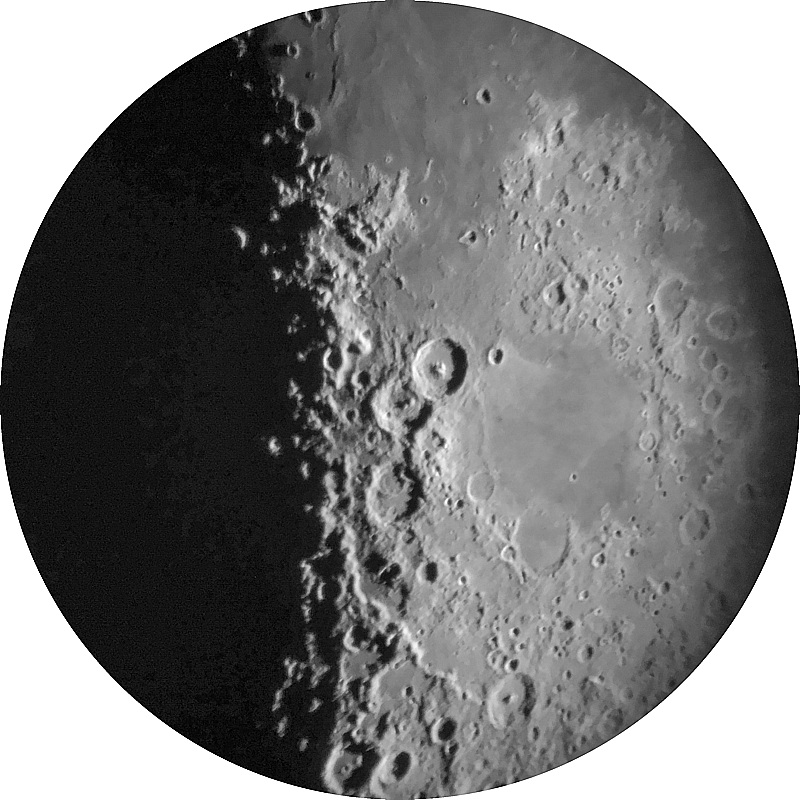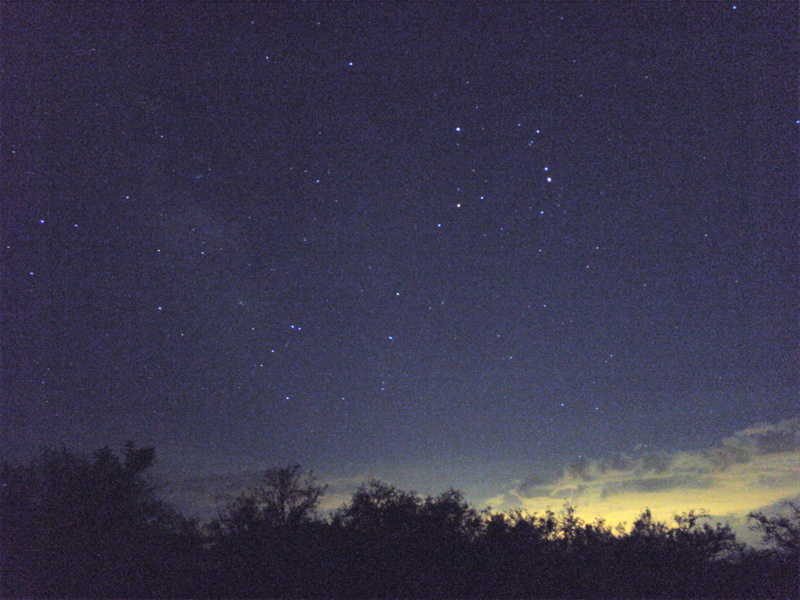Weather Update;
iPhone Astrophotography
Posted: 9 August 2016
Strong Monsoon thunderstorms came through Sunday night, 31 July 2016. Received 1" rain overnight. Some parts of Tucson received over 3" from the storms! Late Monday afternoon, 1 August, more storms were in the area. Got 0.12" rain from one. This black-n-white panorama shows three of the storms to the southwest, west, and northwest:

Click or tap on image for larger version
Tuesday morning, 2 August, another storm came through with 0.35" rain. More storms on Wednesday, 3 August, but only received 0.05" rain. Thursday night, 4 August, after I returned home from the Oracle Dark Skies Committee meeting the sky was mostly cloudy with lightning visible. But some stars were visible. Nice to see they were still there! Friday afternoon, 5 August, another Monsoon thunderstorm came through with lots of lightning and some rain (0.06"). Saturday, 6 August, dawned mostly clear with a forecast of clear skies for the night, however Monsoon storm clouds came in during the afternoon and clouded up the sky by sunset. Sunday, 7 August, remained cloudy. Monday, 8 August, dawned mostly clear with a clear sky forecast for the night. The sky was finally clear enough on Monday, 8 August, to open the observatory.
|
Open: Monday, 8 August 2016, 1814 MST Temperature: 108°F |
Session: 1004 Conditions: Mostly clear, some Monsoon storm clouds |
Equipment Used:
12" f/8 LX600 w/StarLock
Wired AutoStar II handset
2" 24mm UWA eyepiece
2" 9mm 100° eyepiece
2" 2X PowerMate
1.25" 26mm eyepiece
Camera:
iPhone 6s Plus
After opening the observatory I SYNCed the observatory clock to WWV.
1830 MST: LX600 ON, StarLock OFF, High Precision OFF.
1832 MST: viewed the Moon, 102X. Nice view against a bright blue sky. Did some iPhone lunar imaging, afocal 102X, handheld. Posted one image to Twitter and Facebook.
1915 MST: GC Wi-Fi Adapter ON. Used SkySafari 5 Pro on the iPhone 6s Plus to GOTO Venus. The planet was too low for good viewing but was very bright, 102X. 1918 MST: sunset. Used SkySafari to GOTO Mercury, which was higher in the sky. Good view of the planet's half-phase, 102X and 222X. Wi-Fi OFF.
1920 MST: took this iPhone photo of the southwestern sky with a Monsoon storm in the distance and the Moon:

Then did some lunar observing with the 12" telescope, 222X. Good views.
1926 MST: I noticed that Venus was visible to the naked eye low in the western sky.
While I was looking up at the sky the song "Up Above My Head" by Al Hirt was playing on my iPod. That made for nice background music.
Next, did some iPhone lunar imaging. This image was taken handheld, afocal 102X:

The three craters Theophilus, Cyrillus, and Catharina show nicely at the center of this handheld, afocal 222X, image:

1949 MST: viewed Mars, 102X and 222X. Seeing was not great but some details were visible. Next, viewed Jupiter, low in the western sky, 222X. Seeing was really bad but the North and South Equatorial Belts were visible as were the four Galilean Moons. The view was slightly better at 102X. Then viewed Saturn, 102X. The moons Titan, Dione, Rhea, and Tethys were visible. Using 222X the view was pretty good even with some clouds nearby. Cassini Division was clearly visible as were the four moons.
I mounted the iPhone on the 12" telescope using the Orion SteadyPix afocal adapter. I used NightCap Pro (ISO 400, 1/120sec, 2.5X zoom) for this afocal 188X image:

Next, I mounted the iPhone on the GorillaPod and placed it on my POD Roller Desk. Using NightCap Pro (Long Exposure, Light Boost, ISO 8000, 1/3sec, 30 seconds exposure) took this photo of the sky showing the planets Mars and Saturn in the constellation of Scorpius and the Milky Way by the "teapot" of the constellation Sagittarius:

Mouseover or tap on image to see labels
2029 MST: viewed the globular clusters M4 and M22 in the 12" telescope, 102X. M22 was very nice. Decided to image it using the iPhone (with the SteadyPix) and NightCap Pro (Long Exposure, Light Boost, ISO 3200, 1/3sec, 30 seconds exposure), afocal 94X:

That is a pretty impressive image for a cell phone.
2053 MST: ended imaging. I was now seeing lightning flashes in the sky. There were clouds in the southwest and northeast and seemed to be increasing. I decided to close up. This was likely the last session for awhile due to an approaching storm system. This Monsoon season has brought a lot of cloudy nights. As I was closing up the observatory I saw and terminated a Kissing Bug. This was probably the latest in the Kissing Bug season (normally May-June) that I've seen one.
|
Close: Monday, 8 August 2016, 2112 MST Temperature: 83°F |
Session Length: 2h 58m Conditions: Partly cloudy |
The Mac Observer recently interviewed Tim DeBenedictis, co-developer of SkySafari and Director of Mobile Application Development at Simulation Curriculum Corp. You can hear the podcast (38 minutes) at The Mac Observer. I get a mention near the end of the interview!
I have published my review of the book "Uncharted Constellations", a companion book to "The Lost Constellations".
Comments are welcome using Email. Twitter users can use the button below to tweet this report to your followers. Thanks.
Cassiopeia Observatory Home Page
Copyright ©2016 Michael L. Weasner / mweasner@me.com
URL = http://www.weasner.com/co/Reports/2016/08/09/index.html
